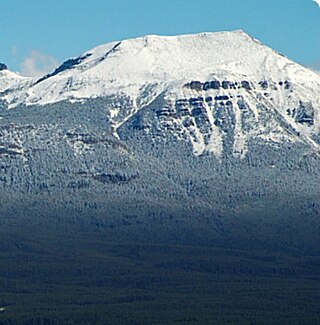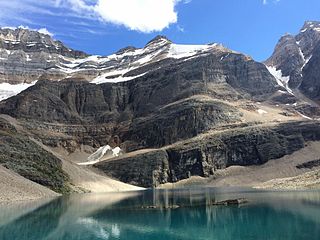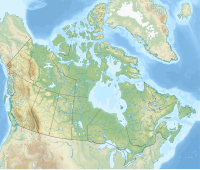
Mount Hungabee, officially Hungabee Mountain, is a mountain located on the boundaries of Banff National Park and Yoho National Park on the Continental Divide at the head of Paradise Valley, in Canada. The peak was named in 1894 by Samuel Allen after the Stoney Indian word for "chieftain" as the mountain is higher than its neighbouring peaks. The mountain can be seen from the Icefields Parkway (#93) in the upper Bow Valley.

Mount Peechee is the third highest peak of the Fairholme Range in Banff National Park. Mt. Peechee is located immediately southeast of Mount Girouard in the Bow River valley south of Lake Minnewanka.

Princess Margaret Mountain is a mountain located in the Bow River valley of Banff National Park, 2.5 km (1.6 mi) west of Mount Charles Stewart.

Mount Saskatchewan is a mountain located in the North Saskatchewan River valley of Banff National Park, in the Canadian Rockies of Alberta, Canada.

Mount Hector is a 3,394-metre (11,135-foot) mountain summit located in the Bow River valley of Banff National Park, in the Canadian Rockies of Alberta, Canada. The mountain was named in 1884 by George M. Dawson after James Hector, a geologist on the Palliser expedition. The mountain is located beside the Icefields Parkway, 17 km (11 mi) north of Lake Louise.

Pilot Mountain is a mountain in the Bow River valley of Banff National Park in Alberta, Canada. It is located southeast of Redearth Creek and directly west of the Trans-Canada Highway.

The Vermilion Range is a mountain range of the Canadian Rockies, in Banff National Park, Canada. The range is east of the Sawback Range and west of the Bare and Palliser Ranges.

Mount Sarbach is a mountain located in Banff National Park between Mistaya River and Howse River and is visible from the Icefields Parkway. The mountain is named after Peter Sarbach, a mountain guide from Switzerland, who guided the first ascent by J. Norman Collie and G.P. Baker in 1897. Mount Sarbach is situated south of Saskatchewan River Crossing, where the Icefields Parkway intersects with the David Thompson Highway.

Mount Bourgeau is a 2,931-metre (9,616 ft) mountain located in the Massive Range of Banff National Park in Alberta, Canada. It was named by James Hector in 1860 after Eugène Bourgeau, a botanist with the Palliser Expedition. Bourgeau Lake sits at the foot of the mountain and is a popular hiking destination.

Mount Brewster is a 2,859-metre (9,380 ft) mountain summit located in the Vermilion Range of Banff National Park, in the Canadian Rockies of Alberta, Canada. Mount Brewster was named in 1929 by Tom Wilson after John Brewster who was the father of the Brewster family of Banff.

Caldron Peak is a 2,911-metre (9,551 ft) mountain peak of the Waputik Range, located in Alberta, Canada. It is prominently visible from the Peyto Lake Overlook in Banff National Park.

Cockscomb Mountain was named in 1921 because the outline of the summit was said to resemble a roosters comb. It is located in the Sawback Range in Alberta. The mountain is composed of sedimentary rock laid down during the Precambrian to Jurassic periods. Formed in shallow seas, this sedimentary rock was pushed east and over the top of younger rock during the Laramide orogeny.

Mount Fifi is located in the Sawback Range of Banff National Park, Alberta. It was named in 1886 after Edith Orde's dog Fifi. Mount Louis, Mount Edith, and Mount Fifi were named on the trip.

Heather Ridge is located in the Slate Range in Alberta. Like other mountains in Banff Park, Heather Ridge is composed of sedimentary rock laid down during the Precambrian to Jurassic periods. Formed in shallow seas, this sedimentary rock was pushed east and over the top of younger rock during the Laramide orogeny.

Lipalian Mountain is a 2,682-metre (8,799-foot) mountain summit located in Banff National Park, in the Slate Range of the Canadian Rockies of Alberta, Canada. It was named by William C. Gussow in 1958.

Massive Mountain is situated in Banff National Park, Alberta, Canada. It is located in the Massive Range and was named in 1918 for its massive size. It however is not the highest summit in the range, that belongs to Mount Brett.

Division Mountain is located on the Continental Divide along the Alberta - British Columbia border of Canada. It also straddles the shared boundary of Banff National Park with Kootenay National Park in the Canadian Rockies. It was named in 1919 by Charles D. Walcott since the mountain divides the Lyell Icefield from the Mons Icefield.

Glacier Peak is located on the border of Alberta and British Columbia in the Canadian Rockies. It was named in 1894 by Samuel E.S. Allen in reference to the glacier on the northern side of the mountain.

Mount Magog is located on the border of Alberta and British Columbia on the Continental Divide in the Canadian Rockies. It also straddles the shared boundary of Banff National Park with Mount Assiniboine Provincial Park. It was named in 1930 after references in the Bible.

Crowfoot Mountain is a mountain within Banff National Park in Alberta, Canada. The Crowfoot Glacier sits on the northeastern flank of the mountain.






















